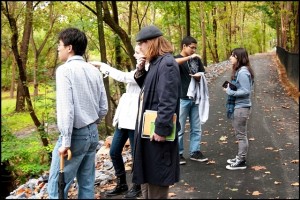Each year during open house events, the faculty stationed at the environmental science poster field many questions from prospective students interested in majoring in environmental degree programs at Lafayette. Now those faculty will have exciting news to share. The College is adding two new offerings to its 47 major areas of study: an A.B. in environmental studies and a B.S. in environmental science.

Brooke Kohler ’13 studied the abundance and spatial distribution of the green iguana in the U.S. Virgin Islands through Lafayette’s environmentally focused Mellon grant.
Both degrees are the culmination of the College’s efforts to enhance its environmental curriculum thanks to a three-year, $800,000 grant from the Andrew W. Mellon Foundation. The grant goes hand in hand with the College’s strategic plan, which calls for a significant increase in Lafayette’s commitment to the study of the natural environment, environmental issues, and environmental policies.
A committee comprised of faculty from across Lafayette’s four divisions as well as two Mellon post-doctoral fellows and chaired by Dru Germanoski, Van Artsdalen Professor and head of geology and environmental geosciences, worked to spearhead the environmental initiative and develop the degree programs. Steven Mylon, associate professor of chemistry, will serve as chair of the new programs.
The A.B. in environmental studies will be grounded in natural sciences but emphasize environmental inquiry and expression in the humanities and social sciences. Students will study the scientific, social, economic, ethical, and political dimensions of environmental systems, explore the environment through the literary, visual, and performing arts, and discuss environmental policy decisions and social change.
The B.S. in environmental science, with its base in foundation sciences such as math, chemistry, and physics, will prepare students to pursue careers as natural scientists or enter graduate programs in natural sciences. By studying the scientific, social, economic, and ethical dimensions of the environment, students will develop the skills to create solutions to environmental problems from local to global scales.
The College has hired Rachel Brummel, who specializes in environmental policy, as the first faculty member devoted to the environmental studies program. As the size of the faculty has grown over the last five years, many new professors across the disciplines have environmental expertise.
“The study of the environment is inherently an interdisciplinary enterprise. With seven billion people on the planet, environmental issues are intricately woven through every human endeavor, and the nature of environmental issues transcends disciplinary boundaries,” explains Germanoski. “The importance of human interactions with the environment is important both locally and globally, and students are intensely interested in environmental inquiry.”

A student team scopes out possible locations for a miniature clay ziggurat sculpture along the Karl Stirner Arts Trail. The project was supported by the College’s Mellon grant.
The College created 12 new environmental courses and enhanced the content of two others, all in the social sciences and humanities. Students pursuing either degree will start by taking the course Introduction to the Environment and end with a capstone project-based course. Both courses will address the scientific as well as the social, ethical, and humanistic aspects of human interaction with the environment. The courses will be team-taught by a mix of professors from the humanities, social sciences, natural sciences, and engineering when possible.
Interest in environmental study among students has been steadily increasing. Lafayette has offered a minor in environmental science since 1991, and students have been flocking to the new environmental focus courses the College has created with the Mellon grant, even though they do not yet count toward a particular major. Also, as these offerings have increased, more students have designed their own majors in environmental studies.
Since 2009, the Mellon grant has supported nearly 40 student-faculty research projects focused on the environment. For example, Jesse Kendra ’14 (Allentown, Pa.), a geology major, worked with Germanoski to investigate surface water and groundwater interactions in a slate/carbonate terrain. Brooke Kohler ’13 (Flemington, N.J.), an anthropology and sociology major, and Jephord English ’12, a policy studies graduate, studied the abundance and spatial distribution of the green iguana in the U.S. Virgin Islands and researched cattle and their effect on the landscape and ecology of the U.S. Virgin Islands with Crystal Fortwangler, Mellon post-doctoral fellow in environmental studies.

Jennifer Bell ’11 performed research on soil management at Lafayette’s Organic Garden near Metzgar Fields as a Mellon Scholar.
Most recently, a team of nine students designed a miniature clay ziggurat sculpture to be located on the floodplains of the Karl Stirner Arts Trail—a mile-and-a-half stretch along the Bushkill Creek connecting the Williams Arts Campus on North Third Street to the proposed Silk Mill arts community on 13th Street. Ed Kerns, Klapp Professor of Art, Nestor Gil, assistant professor of art, Jim Toia, director of the community arts program, and David Brandes and David Veshosky, associate professors of civil and environmental engineering, advised the team. Germanoski allocated about $40,000 of the Mellon grant for the project, which brought three professional artists to campus to mentor the team and will support the sculpture’s completion this fall.
“The Mellon grant made it possible for us to infuse environmental topics into the curriculum and into extracurricular programming to the point that it became part of the fabric of the College,” says Germanoski. “Similarly, the development of these degree programs creates interdisciplinary interaction between faculty and students that becomes an integral part of the College, facilitating additional programming and interdisciplinary interactions focused on the environment.”


